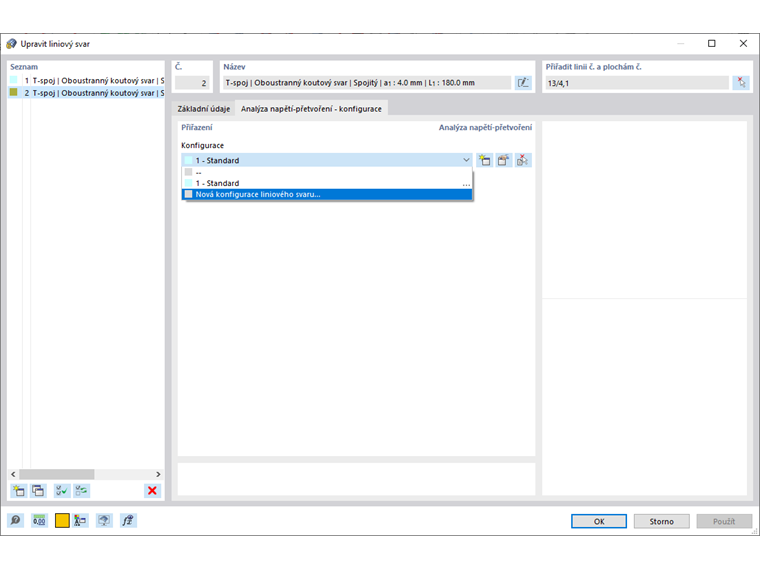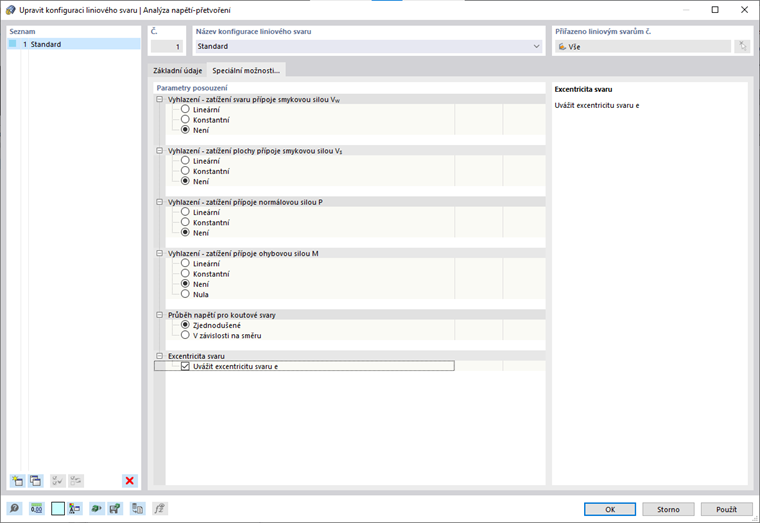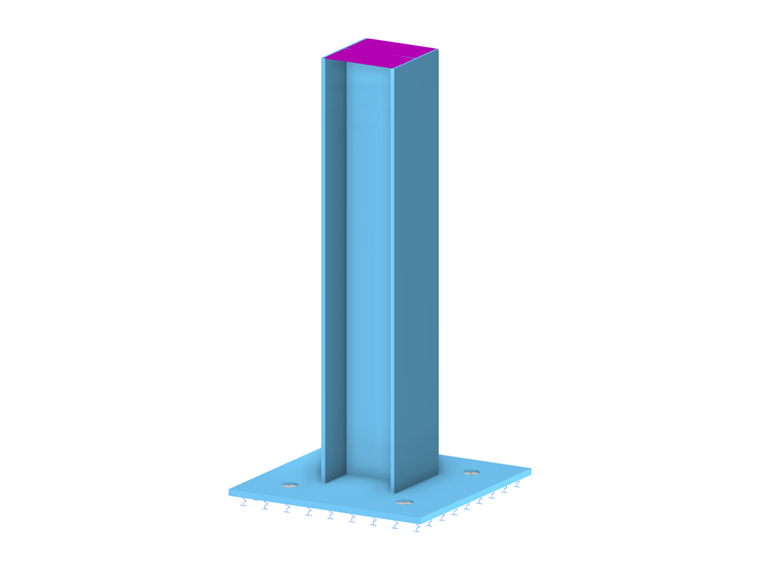Liniový svar lze definovat pomocí dialogového okna „Nový liniový svar“, jak je znázorněno na obrázku 1. Výběr typu spáry je důležitý pro definici liniového svařovaného spoje. V programu je k dispozici několik typů: tupý spoj, rohový spoj, přesahový spoj a T-spoj. Upozorňujeme, že je také nutné definovat typ svaru. Seznam nabízí různé možnosti pro provádění posudků návrhu svarů v závislosti na typu spoje.
Liniové svařované spoje lze uspořádat „kontinuálně“ po celé délce linie. Při zadávání parametrů svaru je tedy nutné přiřadit „velikost svaru“ pro definování tloušťky svaru, zatímco „délka svaru“ se bere z délky linie. U asymetrických konfigurací svarů lze polohu svarové housenky definovat ve vztahu k připojené ploše (červená část v dialogovém okně). Pokud je vybrána možnost „Normála plochy (+z)“, svarová housenka je definována na spodní straně připojené plochy, zatímco možnost „Obrácená normála plochy (-z)“ umožňuje definici na horní straně, aniž by bylo nutné obrátit orientaci plochy.
Liniový svar může být přiřazena k linii, která patří k následně vybraným plochám nebo je do nich integrována. Čísla linií a ploch lze přiřadit v pravém horním rohu dialogového okna nebo výběrem v pracovním okně. Vezměte prosím na vědomí, že pořadí, v jakém je výběr ploch, je libovolný. Podle definice je první plocha vždy považována za „spojenou plochu“ a používá se k určení napětí ve svaru.
Orientace svaru je definována následujícími pravidly:
- ‚‘'w'‚‘ odpovídá ose svaru a je vždy identická s osou ‚'x‘' čáry, na které je definován liniový svar.
- ‚‘'s'‚‘ je orientována paralelně s osou z prvního povrchu z definice liniového svaru (zjednodušená metoda) nebo je paralelní s efektivním hrdlem svaru (směrová metoda).
- ‚‘'j'‚‘ je orientována ortogonálně k rovině ‚'w‘'-‚'s‘'.
Souřadný systém svaru lze aktivovat/deaktivovat pomocí navigátoru zobrazení.
Po vytvoření a přiřazení liniových svarů můžete provést základní specifikace týkající se analýzy liniových svarů. To lze provést na záložce Analýza napětí-přetvoření – Konfigurace ve stejném dialogovém okně (obrázek 4) nebo pomocí položky Analýza napětí-přetvoření v navigátoru (obrázek 5).
Nejprve můžete vybrat složky napětí relevantní pro váš výpočet. Můžete analyzovat normálové napětí ve směru „j“ σj (odpovídá σ⊥ v EN 1993-1-8 [1]), stejně jako příčné napětí ve smyku τs (rovná se τ⊥ v [1]) a podélné napětí ve smyku τw (odpovídá τ‖ podle [1]) v kritických ověřovacích bodech svaru (podrobnější informace naleznete v ). K dispozici jsou také různé srovnávací napětí.
Pro komponenty napětí s definovaným mezním napětím se kromě hodnot napětí provádí také výpočet využití. To znamená, že ověření napětí v souladu s národními normami, jako je EN 1993-1-8 [1], lze provést s minimálním úsilím.
V tomto dialogovém okně jsou k dispozici také speciální možnosti. Můžete například ovládat vyhlazení napětí (tj. průběh lokálních napěťových špiček po délce svaru) a metodu analýzy napětí. U konfigurací svarů s koutovými svary lze napětí určit s ohledem na orientaci spojovaných povrchů (zjednodušená metoda podle normy EN 1993-1-8 [1]) nebo na skloněnou efektivní hrdlo svaru (směrová metoda podle [1).
V případě potřeby lze zohlednit excentricitu svarů. Tímto způsobem mohou vzniknout další momenty, například v případě jednostranných konstrukcí s koutovými svary.
Po dokončení výpočtu jsou napětí v liniových svarech k dispozici v grafické i tabulkové formě. Navigátor umožňuje ovládat, která napětí budou graficky zobrazena, zatímco tabulka poskytuje přehled napětí podle návrhových situací, zatížení, linie a umístění.
Podrobnosti výsledků poskytují další mezilehlé výsledky, jako je úhel Otvor mezi spojenými plochami, úhel sklonu efektivního svarového hrdla nebo síly liniového svaru na jednotku délky M, W, V a P, které tvoří základ pro výpočet napětí.








